








|
deux: Things to do in Montoire when you're
dead
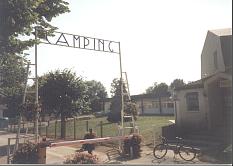
| | Alf's campsite: the
bike is Alf's, on which he patrols the site literally every
few minutes just to make sure nothing is awry.
|
ALF'S campsite opened at 8am and we ordered and shipped some
large cups of coffee before registering. Alf isn't really called Alf,
but he always reminds Stu of Stu's uncle Alf, and, as so often when
Stu names something, the name stuck.
 Stu, who's a bit of a
watercolour artist, presented Alf with a picture he'd done of one of a
village nearby and Alf was so impressed that when we asked him where
we should pitch our tents, he replied "Anywhere" -- which, as Alf
usually runs his campsite to micrometre tolerances as an inscrutable
Big Brother, was a great compliment. Stu, who's a bit of a
watercolour artist, presented Alf with a picture he'd done of one of a
village nearby and Alf was so impressed that when we asked him where
we should pitch our tents, he replied "Anywhere" -- which, as Alf
usually runs his campsite to micrometre tolerances as an inscrutable
Big Brother, was a great compliment.
 We put up the tents -- the
simple two-poles-and-some-bits-of-rope tent I'd borrowed from Stu,
Ian's clever and complicated dome-shaped tent with bendy poles, and
Stu and Jen's equally clever dome-shaped one. Jen immediately fell
fast asleep in the tent, but Stu, Ian and I got the bikes off the cars
and cycled off into Montoire to look for some lunch. We put up the tents -- the
simple two-poles-and-some-bits-of-rope tent I'd borrowed from Stu,
Ian's clever and complicated dome-shaped tent with bendy poles, and
Stu and Jen's equally clever dome-shaped one. Jen immediately fell
fast asleep in the tent, but Stu, Ian and I got the bikes off the cars
and cycled off into Montoire to look for some lunch.
| Q. So how good were we at speaking French? |
|---|
| A. I did GCSE French eight years ago, and
could understand French a fair amount but not speak it myself very
well; Jen did O-level French even longer ago and could only understand
it a bit; Ian did a year out in Toulouse during his degree and speaks
French well enough to be mistaken for a Dutchman; and Stu did French
lessons for a while but then stopped, leaving him with only a
reasonable grip on French but more than enough enthusiasm to make up
the difference.
|
 The supermarket we found, Atac,
would probably have merited several paragraphs of awed description
from a gastronome such as myself -- but we were all far too tired to
pay it the attention it deserved. Only the wine section really woke us
up, where Stu greeted some bottles of Gaillac and Crozes-Hermitage as
if they were long-lost brothers. The wine took up one and a half
sizeable aisles in a supermarket no bigger than the little Sainsbury's
in Cambridge centre. The supermarket we found, Atac,
would probably have merited several paragraphs of awed description
from a gastronome such as myself -- but we were all far too tired to
pay it the attention it deserved. Only the wine section really woke us
up, where Stu greeted some bottles of Gaillac and Crozes-Hermitage as
if they were long-lost brothers. The wine took up one and a half
sizeable aisles in a supermarket no bigger than the little Sainsbury's
in Cambridge centre.
 Stu wanted some fresh
langoustines for lunch, so we also went to the town square to cruise
the local market. The large and very jovial fishmonger, all of whose
produce, Stu translated, had been in the Atlantic until the previous
night, took delight in selling him a kilo of langoustines, and six
oysters. Meanwhile I was quite literally sniffing around the
cheesemonger's stall, where some small cylindrical soft cheeses looked
quite exciting but tasted in fact very boring, another cheese tasted a
bit like Emmental but was extremely expensive, and, at the back, I
noticed some very dark orangey cheese with a little sign saying "18
mois". I didn't actually get any, though. Stu wanted some fresh
langoustines for lunch, so we also went to the town square to cruise
the local market. The large and very jovial fishmonger, all of whose
produce, Stu translated, had been in the Atlantic until the previous
night, took delight in selling him a kilo of langoustines, and six
oysters. Meanwhile I was quite literally sniffing around the
cheesemonger's stall, where some small cylindrical soft cheeses looked
quite exciting but tasted in fact very boring, another cheese tasted a
bit like Emmental but was extremely expensive, and, at the back, I
noticed some very dark orangey cheese with a little sign saying "18
mois". I didn't actually get any, though.
 Ian did really well in the
market: he found a sausagemaker's stall, staffed by a shifty-looking
bloke in a fedora who explained his sausages at some length and got
Ian to taste them all. "This one was the best," he said, waving a
rigid-looking red and white sausage at us, "this one's saucisse sèche
de montagne, and it's got whole peppercorns in. And I got a bit
carried away," he continued, producing something else from his bag,
"and bought this." Ian did really well in the
market: he found a sausagemaker's stall, staffed by a shifty-looking
bloke in a fedora who explained his sausages at some length and got
Ian to taste them all. "This one was the best," he said, waving a
rigid-looking red and white sausage at us, "this one's saucisse sèche
de montagne, and it's got whole peppercorns in. And I got a bit
carried away," he continued, producing something else from his bag,
"and bought this."
 We looked. It was about the
size and shape of a largish cobblestone, and was encrusted with thyme.
"It's called a pavé," said Ian, "which is French for paving stone, or
cobble. It's just like saucisse sèche, but you get a great big lump of
it." We looked. It was about the
size and shape of a largish cobblestone, and was encrusted with thyme.
"It's called a pavé," said Ian, "which is French for paving stone, or
cobble. It's just like saucisse sèche, but you get a great big lump of
it."
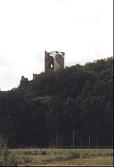  "Good Value!"
exclaimed Stu. To celebrate the pavé, we decided to have a beer at a
bar Stu and Ian knew in the next village, Lavardin. Off we cycled,
soon seeing a pretty little hill with a ruined chateau perched on top. "Good Value!"
exclaimed Stu. To celebrate the pavé, we decided to have a beer at a
bar Stu and Ian knew in the next village, Lavardin. Off we cycled,
soon seeing a pretty little hill with a ruined chateau perched on top.
 "Photo call!" I said, lining
up a shot over the fields. Stu just gave me an enigmatic smile. "Photo call!" I said, lining
up a shot over the fields. Stu just gave me an enigmatic smile.
 I soon found out why. Only
just around the corner (and past a sign saying Lavardin, Un des
plus beaux villages de France) we got a much, much better view of
the chateau, plus a little hillside village, the river Loir, and a
wonderful old stone bridge over it. It was breathtakingly beautiful,
more beautiful than I found it easy to cope with. We stopped at a
riverside path marked Promenade des poêts. I soon found out why. Only
just around the corner (and past a sign saying Lavardin, Un des
plus beaux villages de France) we got a much, much better view of
the chateau, plus a little hillside village, the river Loir, and a
wonderful old stone bridge over it. It was breathtakingly beautiful,
more beautiful than I found it easy to cope with. We stopped at a
riverside path marked Promenade des poêts.
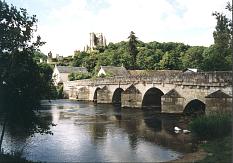
| The 14th-century bridge and 15th to
18th-century château at Lavardin, from the Promenade des poêts. If
you've got image loading turned off, I recommend you load this one
explicitly. Click on the image to see a bigger version (as a 74K
JPEG).
|
 "Now you see why we
come to the same place every year," said Stu. "Now you see
why your suggestion of going off and renting a gîte somewhere else
never really got considered." "Now you see why we
come to the same place every year," said Stu. "Now you see
why your suggestion of going off and renting a gîte somewhere else
never really got considered."
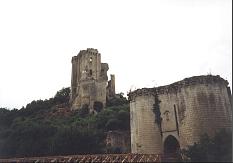 | | The château again, from a bit closer
to. |
 "Ohhhh!
France!" was all I could say. I've never before felt myself relaxing
second by second. The image was actually a little familiar, as Stu
often sets himself the task of painting it -- "but I've never got it
right. You can't, really." "Ohhhh!
France!" was all I could say. I've never before felt myself relaxing
second by second. The image was actually a little familiar, as Stu
often sets himself the task of painting it -- "but I've never got it
right. You can't, really."
 Had it been in England, I felt, the whole zone would have been
horribly commercialised: there would, as Ian said, have been an
ice-cream van. In France, though, they'd laid out a flowerbed. Had it been in England, I felt, the whole zone would have been
horribly commercialised: there would, as Ian said, have been an
ice-cream van. In France, though, they'd laid out a flowerbed.
 We must have spent about twenty minutes there, building up a sense
of wellbeing and calm -- a little of which was dissipated when we went
over the bridge and just up the road to the bar and discovered it was
closed. According to Stu and Ian it in fact had the same "We're
temporarily closed" notice it had had the previous year. We must have spent about twenty minutes there, building up a sense
of wellbeing and calm -- a little of which was dissipated when we went
over the bridge and just up the road to the bar and discovered it was
closed. According to Stu and Ian it in fact had the same "We're
temporarily closed" notice it had had the previous year.
| Lunch |
|---|
| Lunch is taken very seriously in France.
Even some quite major supermarkets close their doors between about
midday and 2-3pm. In small towns like Montoire the effect is both
rapid and complete: at the stroke of noon the whole town retreats
inside like a startled sea anemone.
|
 But we'd seen a bar on
Montoire town square, so we cycled back over the bridge and had some
beers there instead, and watched the market traders scuttling away to
have their lunches, and marriages honking
around the square. It's the French way to honk your horn if you see a
wedding, and then honk your horn at other people to tell them you've
seen a wedding. As Montoire is big enough to have quite a stream of
weddings of a summer Saturday, this meant continual recursive waves of
honking were spreading through the whole town most of the day. But we'd seen a bar on
Montoire town square, so we cycled back over the bridge and had some
beers there instead, and watched the market traders scuttling away to
have their lunches, and marriages honking
around the square. It's the French way to honk your horn if you see a
wedding, and then honk your horn at other people to tell them you've
seen a wedding. As Montoire is big enough to have quite a stream of
weddings of a summer Saturday, this meant continual recursive waves of
honking were spreading through the whole town most of the day.
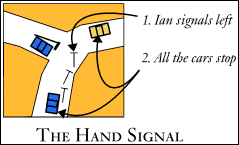  It was
while we were cycling back to the campsite from Montoire centre that
Ian performed The Hand Signal. It was
while we were cycling back to the campsite from Montoire centre that
Ian performed The Hand Signal.
 The Hand Signal was a very impressive piece of roadcraft. It
managed to convey, in one simple gesture, that (a) we were British,
(b) we'd just had a beer, (c) we hadn't slept for 36 hours, and (d) we
wanted to turn left. So well did he get these essential facts across
that seemingly every car in Montoire just stopped and let us get on
with it. The Hand Signal was a very impressive piece of roadcraft. It
managed to convey, in one simple gesture, that (a) we were British,
(b) we'd just had a beer, (c) we hadn't slept for 36 hours, and (d) we
wanted to turn left. So well did he get these essential facts across
that seemingly every car in Montoire just stopped and let us get on
with it.
| Learn to Speak Stu #2: Categories of wine |
|---|
The French, who have to deal with a lot of wine in the course
of their day-to-day existence, have come up with several
classification systems: AOC, VDQS, vin de pays, premier cru, and so
on. Stu, in typical down-to-earth fashion, effectively reduces all
these categories to three:
 Tidy Wine: This is
wine where just having it makes you happy. Occasionally you get it out
of your wine rack, look at the bottle, and put it back. You don't
drink it except when you know beyond reasonable judicial doubt that
the people you're with will appreciate it. Tidy Wine: This is
wine where just having it makes you happy. Occasionally you get it out
of your wine rack, look at the bottle, and put it back. You don't
drink it except when you know beyond reasonable judicial doubt that
the people you're with will appreciate it.
 Quaffing
Wine: This is wine you drink. Quaffing
Wine: This is wine you drink.
 Toilet Wine: This is
wine you buy for your parents. Toilet Wine: This is
wine you buy for your parents.
|
 Once we were back at Alf's
we woke Jen up and started on lunch -- which involved boiling up the
langoustines for a few minutes on Stu's camping stove, and then taking
them to bits and eating them, with a couple of tidy bottles of Vouvray. Once we were back at Alf's
we woke Jen up and started on lunch -- which involved boiling up the
langoustines for a few minutes on Stu's camping stove, and then taking
them to bits and eating them, with a couple of tidy bottles of Vouvray.
 Langoustine is one
of those French words for which even Larousse Gastronomique
doesn't offer an English translation, for the simple reason that the
French are dimly aware that they are wasted on the average Briton and
thus never export any. They're crustaceans (hard luck, all you
orthodox Jews out there) intermediate in size between a king prawn and
a lobster. You cook them for not very long at all, preferably starting
when they're alive, then pull the abdomens off and get the meat out.
You're then faced with something that looks like a prawn but is the
size of your thumb and has a much more delicate taste than a prawn.
All you need to do is dip it in some red wine vinegar you've finely
chopped a shallot into, and it's perfect. Once you discover how tasty
it is, though, it's worth getting some shellfish pliers and cracking
open its claws -- there are some more tasty bits hidden in there,
which presumably Nature had expected no-one ever to be able
to get to. Langoustine is one
of those French words for which even Larousse Gastronomique
doesn't offer an English translation, for the simple reason that the
French are dimly aware that they are wasted on the average Briton and
thus never export any. They're crustaceans (hard luck, all you
orthodox Jews out there) intermediate in size between a king prawn and
a lobster. You cook them for not very long at all, preferably starting
when they're alive, then pull the abdomens off and get the meat out.
You're then faced with something that looks like a prawn but is the
size of your thumb and has a much more delicate taste than a prawn.
All you need to do is dip it in some red wine vinegar you've finely
chopped a shallot into, and it's perfect. Once you discover how tasty
it is, though, it's worth getting some shellfish pliers and cracking
open its claws -- there are some more tasty bits hidden in there,
which presumably Nature had expected no-one ever to be able
to get to.
 The Vouvray went with the
langoustines very well. It's not often you see Stu drinking white
wine, but Vouvray with shellfish is one of the exceptions. For
another, see later. The Vouvray went with the
langoustines very well. It's not often you see Stu drinking white
wine, but Vouvray with shellfish is one of the exceptions. For
another, see later.
 We'd got the oysters for Jen, but I had one to try, as I'd never
eaten oyster before. Any animal cruelty zealots who were put off with
the idea of boiling langoustines alive and cracking them open with
pliers should stop reading now, for what we did to the oysters was
even more barbaric. We didn't even cook them. We'd got the oysters for Jen, but I had one to try, as I'd never
eaten oyster before. Any animal cruelty zealots who were put off with
the idea of boiling langoustines alive and cracking them open with
pliers should stop reading now, for what we did to the oysters was
even more barbaric. We didn't even cook them.
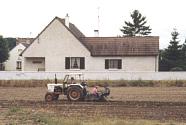 | | This old couple
were sitting on the back of the tractor, she sorting plants
out from a pile, he methodically throwing them into a
trench at the right interval. The tractor was going at a
slow horse's pace. It's ancient round here.
|
 They were sold live in the
market, and we kept them in a bucket of water until after lunch. Then
we took each one, rammed an oyster knife in at the hinge end to get it
open, poured out the brine, added a little shallot vinegar, and ate it
raw straight out of the bottom shell. It was soft and creamy and
sealike and shallotty and I was an instant addict. "Ah," said Stu, "a
dozen oysters next time." They were sold live in the
market, and we kept them in a bucket of water until after lunch. Then
we took each one, rammed an oyster knife in at the hinge end to get it
open, poured out the brine, added a little shallot vinegar, and ate it
raw straight out of the bottom shell. It was soft and creamy and
sealike and shallotty and I was an instant addict. "Ah," said Stu, "a
dozen oysters next time."
 Having just described that meal as "lunch", it should be said that
it was now about 4pm. We all then decided we needed some sleep, and
had a snooze until we all got up thinking it was time for supper. Having just described that meal as "lunch", it should be said that
it was now about 4pm. We all then decided we needed some sleep, and
had a snooze until we all got up thinking it was time for supper.
 Supper was rather more modest than lunch: some French ham, a pack
of cold cooked potatoes, and some broad beans specially imported by
Stu from his own back garden in Cambridge. Only a couple of quaffy
bottles of wine accompanied it: we were all glad to get to bed. Supper was rather more modest than lunch: some French ham, a pack
of cold cooked potatoes, and some broad beans specially imported by
Stu from his own back garden in Cambridge. Only a couple of quaffy
bottles of wine accompanied it: we were all glad to get to bed.


 All Rites
Reversed -- Copy What You Like All Rites
Reversed -- Copy What You Like
|





